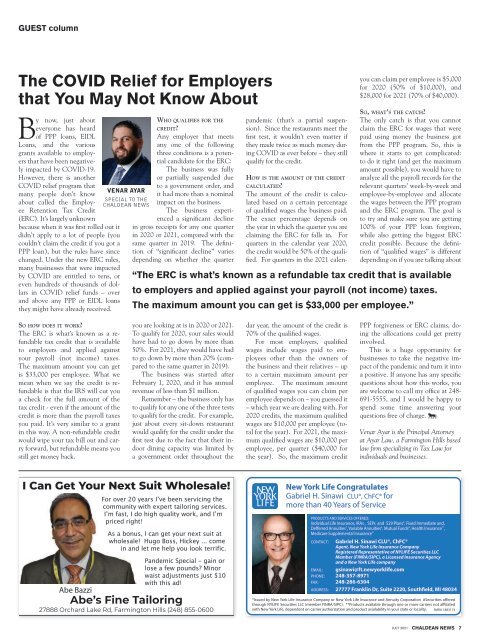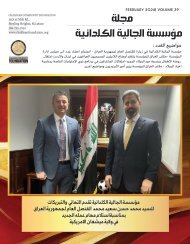JULY 2021
You also want an ePaper? Increase the reach of your titles
YUMPU automatically turns print PDFs into web optimized ePapers that Google loves.
GUEST column<br />
The COVID Relief for Employers<br />
that You May Not Know About<br />
By now, just about<br />
everyone has heard<br />
of PPP loans, EIDL<br />
Loans, and the various<br />
grants available to employers<br />
that have been negatively<br />
impacted by COVID-19.<br />
However, there is another<br />
COVID relief program that<br />
many people don’t know<br />
about called the Employee<br />
Retention Tax Credit<br />
(ERC). It’s largely unknown<br />
because when it was first rolled out it<br />
didn’t apply to a lot of people (you<br />
couldn’t claim the credit if you got a<br />
PPP loan), but the rules have since<br />
changed. Under the new ERC rules,<br />
many businesses that were impacted<br />
by COVID are entitled to tens, or<br />
even hundreds of thousands of dollars<br />
in COVID relief funds – over<br />
and above any PPP or EIDL loans<br />
they might have already received.<br />
VENAR AYAR<br />
SPECIAL TO THE<br />
CHALDEAN NEWS<br />
Who qualifies for the<br />
credit?<br />
Any employer that meets<br />
any one of the following<br />
three conditions is a potential<br />
candidate for the ERC:<br />
The business was fully<br />
or partially suspended due<br />
to a government order, and<br />
it had more than a nominal<br />
impact on the business.<br />
The business experienced<br />
a significant decline<br />
in gross receipts for any one quarter<br />
in 2020 or <strong>2021</strong>, compared with the<br />
same quarter in 2019. The definition<br />
of “significant decline” varies<br />
depending on whether the quarter<br />
pandemic (that’s a partial suspension).<br />
Since the restaurants meet the<br />
first test, it wouldn’t even matter if<br />
they made twice as much money during<br />
COVID as ever before – they still<br />
qualify for the credit.<br />
How is the amount of the credit<br />
calculated?<br />
The amount of the credit is calculated<br />
based on a certain percentage<br />
of qualified wages the business paid.<br />
The exact percentage depends on<br />
the year in which the quarter you are<br />
claiming the ERC for falls in. For<br />
quarters in the calendar year 2020,<br />
the credit would be 50% of the qualified.<br />
For quarters in the <strong>2021</strong> calen-<br />
you can claim per employee is $5,000<br />
for 2020 (50% of $10,000), and<br />
$28,000 for <strong>2021</strong> (70% of $40,000).<br />
So, what’s the catch?<br />
The only catch is that you cannot<br />
claim the ERC for wages that were<br />
paid using money the business got<br />
from the PPP program. So, this is<br />
where it starts to get complicated:<br />
to do it right (and get the maximum<br />
amount possible), you would have to<br />
analyze all the payroll records for the<br />
relevant quarters’ week-by-week and<br />
employee-by-employee and allocate<br />
the wages between the PPP program<br />
and the ERC program. The goal is<br />
to try and make sure you are getting<br />
100% of your PPP loan forgiven,<br />
while also getting the biggest ERC<br />
credit possible. Because the definition<br />
of “qualified wages” is different<br />
depending on if you are talking about<br />
“The ERC is what’s known as a refundable tax credit that is available<br />
to employers and applied against your payroll (not income) taxes.<br />
The maximum amount you can get is $33,000 per employee.”<br />
So how does it work?<br />
The ERC is what’s known as a refundable<br />
tax credit that is available<br />
to employers and applied against<br />
your payroll (not income) taxes.<br />
The maximum amount you can get<br />
is $33,000 per employee. What we<br />
mean when we say the credit is refundable<br />
is that the IRS will cut you<br />
a check for the full amount of the<br />
tax credit - even if the amount of the<br />
credit is more than the payroll taxes<br />
you paid. It’s very similar to a grant<br />
in this way. A non-refundable credit<br />
would wipe your tax bill out and carry<br />
forward, but refundable means you<br />
still get money back.<br />
you are looking at is in 2020 or <strong>2021</strong>.<br />
To qualify for 2020, your sales would<br />
have had to go down by more than<br />
50%. For <strong>2021</strong>, they would have had<br />
to go down by more than 20% (compared<br />
to the same quarter in 2019).<br />
The business was started after<br />
February 1, 2020, and it has annual<br />
revenue of less than $1 million.<br />
Remember – the business only has<br />
to qualify for any one of the three tests<br />
to qualify for the credit. For example,<br />
just about every sit-down restaurant<br />
would qualify for the credit under the<br />
first test due to the fact that their indoor<br />
dining capacity was limited by<br />
a government order throughout the<br />
dar year, the amount of the credit is<br />
70% of the qualified wages.<br />
For most employers, qualified<br />
wages include wages paid to employees<br />
other than the owners of<br />
the business and their relatives – up<br />
to a certain maximum amount per<br />
employee. The maximum amount<br />
of qualified wages you can claim per<br />
employee depends on – you guessed it<br />
– which year we are dealing with. For<br />
2020 credits, the maximum qualified<br />
wages are $10,000 per employee (total<br />
for the year). For <strong>2021</strong>, the maximum<br />
qualified wages are $10,000 per<br />
employee, per quarter ($40,000 for<br />
the year). So, the maximum credit<br />
PPP forgiveness or ERC claims, doing<br />
the allocations could get pretty<br />
involved.<br />
This is a huge opportunity for<br />
businesses to take the negative impact<br />
of the pandemic and turn it into<br />
a positive. If anyone has any specific<br />
questions about how this works, you<br />
are welcome to call my office at 248-<br />
691-5555, and I would be happy to<br />
spend some time answering your<br />
questions free of charge.<br />
Venar Ayar is the Principal Attorney<br />
at Ayar Law, a Farmington Hills based<br />
law firm specializing in Tax Law for<br />
individuals and businesses.<br />
New York Life Congratulates<br />
Gabriel H. Sinawi CLU®, ChFC® for<br />
more than 40 Years of Service<br />
PRODUCTS AND SERVICES OFFERED:<br />
Individual Life Insurance, IRAs , SEPs and 529 Plans # , Fixed Immediate and,<br />
Defferred Annuities * , Variable Annuities # , Mutual Funds # , Health Insurance ** ,<br />
Medicare Supplemental Insurance **<br />
CONTACT: Gabriel H. Sinawi CLU®, ChFC®<br />
Agent, New York Life Insurance Company<br />
Registered Representative of NYLIFE Securities LLC<br />
Member (FINRA/SIPC), a Licensed Insurance Agency<br />
and a New York Life company<br />
EMAIL: gsinawi@ft.newyorklife.com<br />
PHONE: 248-357-8971<br />
FAX: 248-286-6304<br />
ADDRESS: 27777 Franklin Dr, Suite 2220, Southfield, MI 48034<br />
*Issued by New York Life Insurance Company or New York Life Insurance and Annuity Corporation #Securities offered<br />
through NYLIFE Securities LLC (member FINRA/SIPC). **Products available through one or more carriers not affiliated<br />
with New York Life, dependent on carrier authorization and product availability in your state or locality. SMRU 1883174<br />
<strong>JULY</strong> <strong>2021</strong> CHALDEAN NEWS 7

















